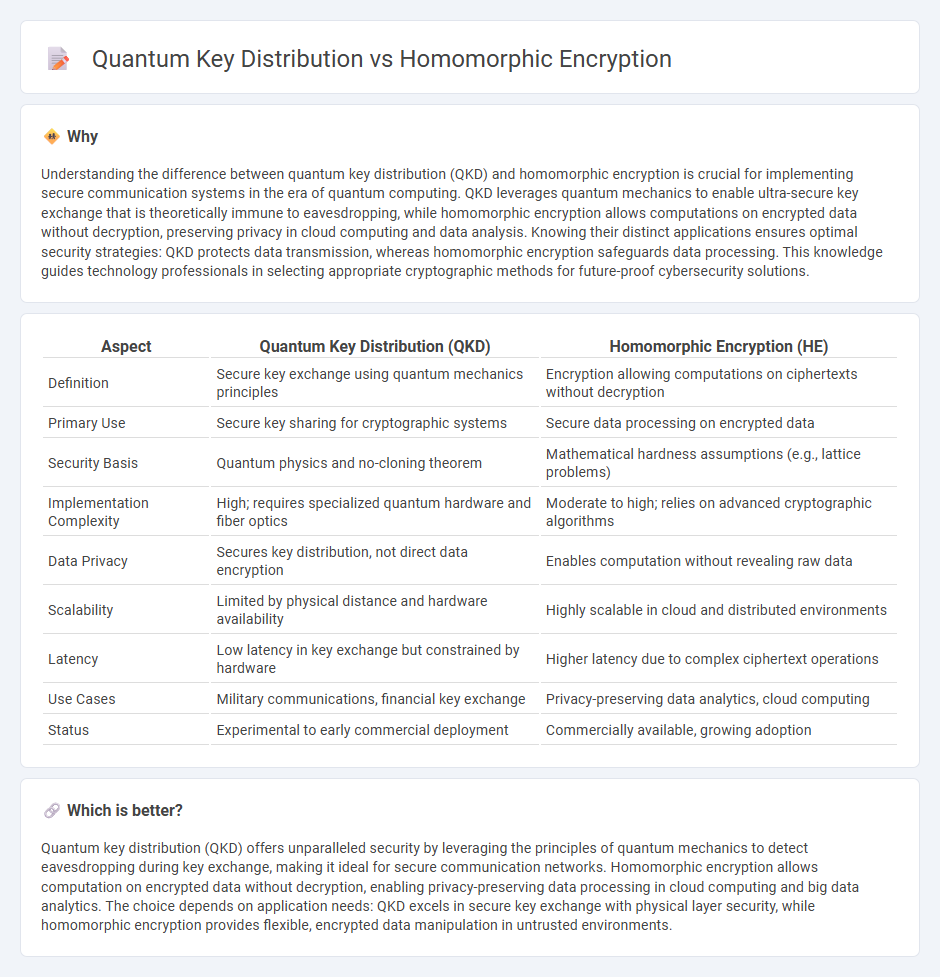
Quantum key distribution (QKD) leverages the principles of quantum mechanics to enable secure communication by detecting eavesdropping during key exchange. Homomorphic encryption allows computations on encrypted data without decryption, preserving data privacy in cloud and multi-party environments. Explore the distinct advantages and applications of these cutting-edge cryptographic technologies to enhance cybersecurity strategies.
Why it is important
Understanding the difference between quantum key distribution (QKD) and homomorphic encryption is crucial for implementing secure communication systems in the era of quantum computing. QKD leverages quantum mechanics to enable ultra-secure key exchange that is theoretically immune to eavesdropping, while homomorphic encryption allows computations on encrypted data without decryption, preserving privacy in cloud computing and data analysis. Knowing their distinct applications ensures optimal security strategies: QKD protects data transmission, whereas homomorphic encryption safeguards data processing. This knowledge guides technology professionals in selecting appropriate cryptographic methods for future-proof cybersecurity solutions.
Comparison Table
| Aspect | Quantum Key Distribution (QKD) | Homomorphic Encryption (HE) |
|---|---|---|
| Definition | Secure key exchange using quantum mechanics principles | Encryption allowing computations on ciphertexts without decryption |
| Primary Use | Secure key sharing for cryptographic systems | Secure data processing on encrypted data |
| Security Basis | Quantum physics and no-cloning theorem | Mathematical hardness assumptions (e.g., lattice problems) |
| Implementation Complexity | High; requires specialized quantum hardware and fiber optics | Moderate to high; relies on advanced cryptographic algorithms |
| Data Privacy | Secures key distribution, not direct data encryption | Enables computation without revealing raw data |
| Scalability | Limited by physical distance and hardware availability | Highly scalable in cloud and distributed environments |
| Latency | Low latency in key exchange but constrained by hardware | Higher latency due to complex ciphertext operations |
| Use Cases | Military communications, financial key exchange | Privacy-preserving data analytics, cloud computing |
| Status | Experimental to early commercial deployment | Commercially available, growing adoption |
Which is better?
Quantum key distribution (QKD) offers unparalleled security by leveraging the principles of quantum mechanics to detect eavesdropping during key exchange, making it ideal for secure communication networks. Homomorphic encryption allows computation on encrypted data without decryption, enabling privacy-preserving data processing in cloud computing and big data analytics. The choice depends on application needs: QKD excels in secure key exchange with physical layer security, while homomorphic encryption provides flexible, encrypted data manipulation in untrusted environments.
Connection
Quantum key distribution (QKD) and homomorphic encryption both enhance cybersecurity by addressing different stages of secure communication; QKD uses quantum mechanics principles to generate and share encryption keys with unconditional security, while homomorphic encryption allows computations on encrypted data without decryption, preserving data privacy. Integrating QKD with homomorphic encryption can create ultra-secure communication channels where encryption keys are securely shared and data can be processed securely in cloud environments. This synergy is pivotal for advancing secure data transmission and processing in quantum-resistant cryptographic frameworks.
Key Terms
Data Privacy
Homomorphic encryption enables secure computation on encrypted data without revealing the plaintext, ensuring robust data privacy during processing. Quantum key distribution (QKD) offers theoretically unbreakable encryption keys by leveraging quantum mechanics, safeguarding data transmission against future quantum attacks. Explore the detailed advantages of homomorphic encryption and QKD in enhancing data privacy.
Quantum Security
Homomorphic encryption enables computations on encrypted data without decryption, offering strong data privacy in classical and post-quantum contexts. Quantum key distribution (QKD) provides security based on quantum mechanics principles, allowing secure key exchange that resists quantum attacks. Explore the latest advancements and practical applications of both technologies to understand their roles in future quantum security frameworks.
Cryptographic Protocols
Homomorphic encryption enables computation on encrypted data without decryption, ensuring data privacy during processing, while quantum key distribution (QKD) provides unconditionally secure key exchange based on quantum mechanics principles. Homomorphic encryption protocols rely on complex mathematical structures like lattices to secure data, whereas QKD protocols exploit quantum phenomena such as photon polarization to detect eavesdropping. Explore the latest advancements and practical implementations of these cryptographic protocols to understand their impact on secure communication systems.
Source and External Links
Homomorphic encryption - Wikipedia - Homomorphic encryption is a type of encryption that allows computations to be performed directly on encrypted data without decrypting it first, keeping the result encrypted; types include partially, somewhat, leveled fully, and fully homomorphic encryption, with fully homomorphic offering the ability to evaluate arbitrary circuits with unbounded depth.
What is homomorphic encryption, and why isn't it mainstream? - Homomorphic encryption enables mathematical operations on encrypted data so that the encrypted result, when decrypted, matches the result of operations performed on plaintexts, solving the challenge of preserving encryption while allowing computations.
What Is Homomorphic Encryption? - Chainlink - Homomorphic encryption is a cryptographic method allowing computations on encrypted data without decryption, existing as partially homomorphic, somewhat homomorphic, leveled fully homomorphic, and fully homomorphic types, each supporting different operational capabilities and complexity levels.
 dowidth.com
dowidth.com